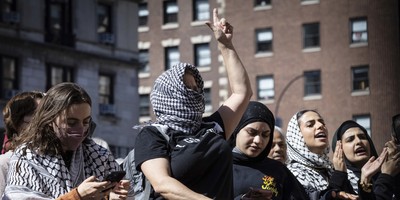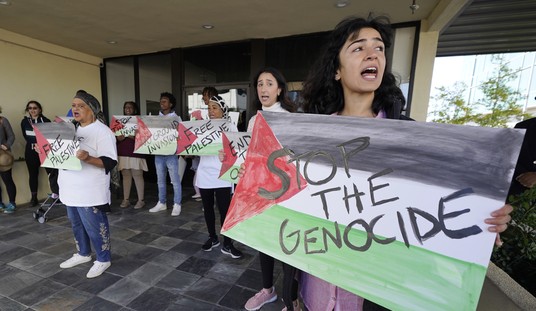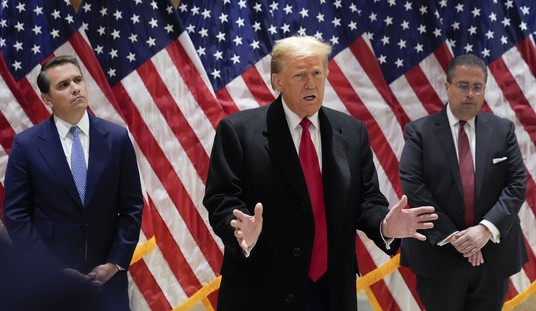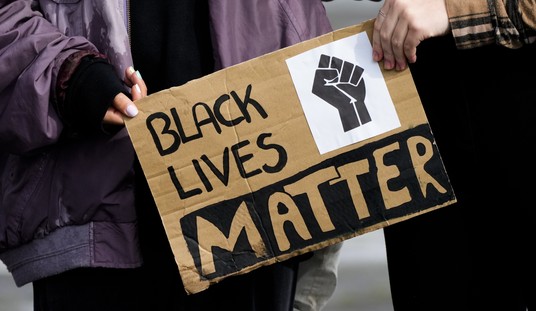As Occupy Wall Street demonstrations have gone national and now global, observers are taking note of the prominent role of labor unions in this anti-business crusade. The rote denunciations of “corporate greed” at these events could be lifted from almost any AFL-CIO convention speech. This doesn’t necessarily mean, of course, that union organizers are putting words in protestors’ mouths. Yet it does underscore the existence of a longstanding alliance between organized labor and street radicalism.
Given their overlapping worlds, it’s fitting that one of the prime movers behind this far-Left sturm und drang is the Service Employees International Union (SEIU), some of whose operatives are skilled in wrecking reputations of major companies (like the corporate campaign against Sodexo, about which I wrote in these pages a few months ago). And there are plenty of other unions getting in on the action.
Occupy Wall Street began on September 17. On that day, anti-capitalist radicals gathered in Lower Manhattan at Zuccotti Park, not far from the World Trade Center site, to voice their displeasure over what they saw as legalized robbery by the country’s financial services industry, and corporations generally, of the nation. The protestors claimed to represent “99 percent” of America, the portion getting the shaft from the wealthiest 1 percent. They redubbed the space “Liberty Park,” an informal return to the area’s original name, Liberty Square Park.
Organizers knew what they were doing. Because the park is privately-owned and operated (by Brookfield Office Properties), it is not subject to City of New York curfew rules. Yet because it is public space, it must stay open 24 hours a day, a fact Police Commissioner Raymond Kelly reluctantly explained to the public.
The movement quickly captured the imagination of a loose coalition of socialists, anarchists, clergy, teachers, students, hackers, environmentalists and other activists across the nation. Here was the spontaneous outpouring of the people that we’d all been waiting for, said organizers – Ground Zero for the Revolution! Soon enough, Occupy Wall Street inspired dozens of copycat movements bearing names such as Occupy Atlanta, Occupy Boston and Occupy Pittsburgh.
Superficially, Occupy Wall Street is the Left’s equivalent of the Right’s Tea Parties. Each movement – its leadership anyway – seeks to transform widespread discontent over federal bailouts of banks and corporations into a broad populist program. Each seeks to recruit followers via carnival-style rallies. Each seeks to expose incestuous relationships between business and political elites. And each considers itself to be the essence of patriotism, a fulfillment of our Founders’ vision.
Recommended
Vice President Joe Biden, for one, sees a parallel. Occupy Wall Street protests, he recently told Washington Ideas Forum, have “a lot in common with the Tea Party.” He elucidated: “Let’s be honest with each other. What is the core of that protest? The core is the bargain has been breached with the American people. The American people do not think the system is fair.”
Yet Occupy Wall Street, along with its roughly 140 “branch offices” around the nation, plus hundreds more worldwide, operates on a very different set of assumptions than the Tea Party. True, each opposes crony capitalism. But whereas Tea Partiers see far too much government economic intervention, Occupy Wall Street activists see far too little.
The latter’s desire for public control over the economy and severe punishment of presumed malefactors of wealth isn’t immediately apparent amid the feel-good anarchist-communitarian vibes. But it’s there. In Chicago, for example, thousands of protestors recently marched along Michigan Avenue chanting, “Tax, tax, tax the rich.” As a variation, a prominently displayed sign during demonstrations in Manhattan’s financial district declared “Eat the Rich.” Meanwhile, Association of Community Organizations for Reform Now (ACORN) founder and former chief organizer Wade Rathke is celebrating the protests as an “anti-banking jihad.” And a week ago in Hong Kong, a 22-year-old art student declared: “I want to tear down capitalism.” The central problem of our economy to such people is not the corruption of the market; it’s the market itself.
Occupy Wall Street’s brief mission statement, published on its web site (www.occupywallst.org), is saturated with hard-Left populism:
Occupy Wall Street is a leaderless resistance movement with people of many colors, genders and political persuasions. The one thing we all have in common is that We Are The 99% that will no longer tolerate the greed and corruption of the 1%. We are using the revolutionary Arab Spring tactic to achieve our ends and encourage the use of nonviolence to maximize the safety of all participants.
Elsewhere on the website, an anonymous author confronts the putative ruling class with the equivalent of a defiant fist: “We do not fear your power and we will continue to fight for a better world. We will never stop growing and each day we’ll continue to expand, block by block and city by city.”
This leads to a second defining feature of Occupy Wall Street: its style, embodied by a penchant for aggressive and often illegal modes of confrontation. Consider the defining word in the group’s name: “occupy.” Activists have cultivated a paramilitary style of forcibly taking over – as opposed to renting or visiting – parks, streets and other public spaces to advance their political purposes. The “nonviolence” that campaign organizers and apologists claim to be their defining tactic is a ruse. There is nothing peaceful or legal about invading someone else’s property, regardless of the reason. Even public property implies the existence of an unbreakable trust with the taxpaying public. Tea Parties, to be sure, have had their share of unappealing eccentrics, but none have resorted to this sort of menace. They typically were one-day affairs during which participants behaved reasonably.
“Reasonable” is not a word that comes to mind when observing the behavior of Occupy Wall Street and related campaigns. In Washington, D.C., protestors burnt at least one dollar bill outside Federal Reserve headquarters; so far as one knows, even the most fervent supporters of Texas Republican Congressman and presidential candidate Ron Paul – the Fed’s worst nightmare – haven’t resorted to such behavior. In New York, an Occupy Wall Street demonstrator defecated on an NYPD patrol car. Elsewhere in the city, hundreds of protestors marched along Fifth and Park Avenues, stopping in front of buildings where corporate CEOs reside in order to heckle and shout up at their windows. In a separate New York incident, about 700 protestors were arrested on the Brooklyn Bridge when they defied a police order and continued to block traffic. In Chicago, a contingent of protestors blocked rush hour traffic, while another marched on a hotel where the Mortgage Bankers Association of America (MBAA) had been holding a meeting. And in Boston during the wee hours of Tuesday, October 11, police arrested some 100 demonstrators who refused to leave a section of the Rose Fitzgerald Kennedy Greenway; protestors had been living in makeshift tents this month in nearby Dewey Square Park before expanding their domain.
The Occupy Wall Street movement, in essence, is anti-capitalist street theater seeking to become a mass political movement. And labor unions have the resources to make that happen. That’s why their leaders are getting involved, directly or through radical nonprofit organizations.
A good example of the latter, in the context of Occupy Wall Street, is the network of the Working Families Party (WFP), a Brooklyn, N.Y.-based multi-state entity founded in 1998 as a radical alternative to mainstream Democrats. A WFP spokeswoman, Nelini Stamp, describes her role in Occupy Wall Street as “part of the organizing team and the outreach team that has managed to bridge the distance between that first day and this day and between the grassroots folks here and the labor movement.” She doesn’t shrink from expressing her intentions. Demonstrators, she told Free Speech TV reporter Laura Flanders, are “actually trying to change the capitalist system we have today because it’s not working for any of us,” and are asking, “How do we really reform and bring revolutionary changes to the states?”
In addition to being a deceptively influential player, the Working Families Party from the start has been a front group for ACORN, which formally disbanded last year following revelations of impropriety and which since has reconstituted itself under various guises. The WFP operates out of ACORN’s New York chapter office suite in Brooklyn. Its executive director is former ACORN operative Dan Cantor. New York Communities for Change (NYCC), the successor organization to ACORN’s New York chapter, is headed by longtime ACORN lobbyist Jon Kest and also is a key participant in the Manhattan demonstrations. And New England United for Justice, which helped spearhead Occupy Boston, is headed by former ACORN National President Maude Hurd.
ACORN and the Working Families Party have owed much of their public profile to union activism, getting help from the Communications Workers of America (CWA) and the United Auto Workers (UAW). Two of the party’s three current co-chairs are Bob Master and Sam Williams, respectively, officials with the CWA and the UAW. The other WFP chairperson is former ACORN Executive Director Bertha Lewis, who took over the nonprofit network from Wade Rathke in 2008.
Unions, in fact, have helped create protests across the nation. In Southern California, dozens of Occupy Orange County protestors marched outside a Chase Bank in Anaheim and vowed to march on additional banks; the group is led by the Orange County Labor Federation. In Chicago, the Chicago Federation of Labor worked closely with Occupy Chicago in marching on the MBAA and Futures and Options Expo conferences. And in Boston, the Greater Boston Labor Council lauded the group Occupy Boston for shining “a spotlight on the imbalance of power in our nation and the role that Wall Street has played in devastating our economy.” Each of these labor federations are affiliated with the AFL-CIO.
It is in New York where unions are pouring in the most resources. The Amalgamated Transit Union (ATU) has publicly endorsed Occupy Wall Street. Its president, Larry Hanley, a member of the AFL-CIO executive committee, praises local members for voicing “huge support” for Occupy Wall Street. “Working people’s voices have been drowned out by huge money,” he states. The New York State United Teachers (NYSUT), also allied with the AFL-CIO, has endorsed Occupy Wall Street as well. Sounding like the protestors, NYSUT spokesman Carl Korn explains: “Teachers and public employees represent the other 99 percent; they are not in the 1 percent. We’re supportive of that overarching message.” The national leadership of the American Federation of State, County and Municipal Employees (AFSCME) and the CWA also support the demonstrators. Prominent New York City-area unions providing backing include Service Employees Local 1199 and Transport Workers Union Local 100. Support consists of more than words. Unions have bused members to Zuccotti Park, conducted onsite teach-ins, and strategized with Occupy Wall Street leaders. SEIU Local 1199 in particular has supplied clothes, water and pizza to occupiers. The big cheese himself, AFL-CIO President Richard Trumka, recently paid them a visit.
If one union leader has the ability to instill revolutionary discipline and aggression in the seemingly anarchic, non-hierarchical world of the protestors, it is Stephen Lerner, a board member and longtime operative of SEIU. His specialty is undermining the reputations of banks and corporations. Way back during the mid Eighties, the shadowy Lerner helped launch the union’s “Justice for Janitors” campaign in cities across the U.S., using various tactics of public intimidation to force hotel and other high-rise building contractors into signing master contracts with unorganized workers. This past March he was caught on audiotape speaking before an audience at Pace University in Manhattan unveiling a five-point plan to undermine the U.S. economy (via mass refusal to repay mortgage loans, among other tactics), a campaign to be led by the SEIU and other unions, with selected community groups serving as fronts.
Lerner is trying to reap the whirlwind of this moment in history. At an October 3 conference in Washington, D.C., “Take Back the American Dream,” he remarked: “We have solutions. We just have to build it bigger and larger.” He believes in making CEOs into public pariahs. At a meeting of SEIU Local 1775 in Seattle on September 22, he declared: “We’ve got to be clear on the human beings who are bad,” citing JP Morgan Chase CEO Jamie Dimon as a prime example. Lerner sees the ultimate bad guys as comprising not even 1 percent of the population. In a 2007 interview, he stated: “We literally have a handful of billionaires that are marauding around the globe, buying and selling things, and they need to be held accountable.” He may well be behind some of the recent urban occupations, too – a recent photo of an Occupy Chicago rally would suggest as much.
For now, Occupy Wall Street is mostly a motley collection of activists whose apparent lack of formal direction renders them, at least to the casual observer, rather benign. But looks are deceiving. The movement does have leadership. And to expand its base, it will seek to establish linkages with other activists in the progressive pantheon.
This is nature asserting itself. All political movements, in order to be self-sustaining, must centralize decision-making. Even the most “spontaneous” requires a bureaucracy through which a relatively small number of people at the top engage in networking, planning and logistics. That way, the amateur majority can make history to their hearts’ content. This classic “Iron Law of Oligarchy,” one might add, holds true for activism on the Right – the Tea Parties never could have happened without extensive stage management. Politics requires expertise and commitment, two things in perpetual short supply.
Unions, in other words, are very likely to serve as the vanguard of an expanded Occupy Wall Street movement. For when it comes to weakening corporations, labor organizations have expertise and commitment. And they’re more than happy to share them with the demonstrators.

























Join the conversation as a VIP Member